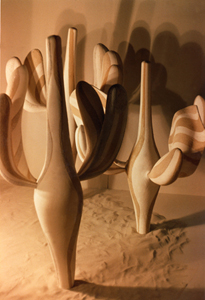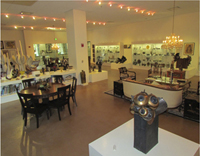
About the Gallery | About the Artist | The Artist's Exhibitions | The Artist's Historical Significance
Thoughts on Helen Richter Watson | Gallery Opening
The Artist’s Art and its Historical Significance
Helen Richter Watson's distinctive and historically noteworthy approach to ceramic art and design first began to coalesce during her college years in southern California. As an undergraduate student at Scripps College in the mid-to-late 1940s, this Laredo native could draw on the emphatic influence of the emerging studio crafts movement, where the artistic emphasis was placed on drawing as a means to formal conception (as it long had been in the so-called "major" arts of painting and sculpture), and where the integration of form and color was paramount.
This movement was particularly strong in California, and it was Watson's great good fortune to be a maturing ceramic artist in this place, at this time. The Austrian potters Gertrude Natzler (1908-71) and Otto Natzler (1908- 2007 ) had settled in Los Angeles in the late 1930s to escape the Nazi annexation of their native country, and their work exemplifies these tendencies, as they concentrated on "combining elegant, classical forms with colourful and textural glaze effects." An early color snapshot from 1949 of the young artist (shown in her 1979 retrospective catalogue) with the accomplishments of her masters-level work at Claremont Graduate School indicates how much her own work embodied these characteristics.
The influences on American ceramics were also expanding at this time. Ideas from Surrealism, Abstract Expressionism, improvisational jazz, and Japanese ceramics were being embraced as modalities of inspiration and influence. Ceramists like Peter Voulkos (1924-2002) were fully engaged with a "high level of expressive experimentalism" at Otis Art Institute in Los Angeles by the early 1950s. When Helen Watson became chair for the Ceramics program at Otis in 1958, shortly after the departure of Voulkos, she had already exhibited and lectured nationally, and had won a prestigious fellowship from the Swedish government to continue her research; she integrated the new approaches of artists like Voulkos gracefully and compellingly into her own rich and complex oeuvre.
Unlike Voulkos, though, Watson integrated the gesturalism of Voulkos's approach into her overall design for a piece from the beginning rather than utilizing it as a culminating, expressive climax to the creative process. (See, for example, her striking stoneware planter and flower forms of the late 1960s and 70s--forms that reflect as well the influence of ancient Jomon forms from Japan.)
Overall, it is Watson's complexly integrative approach--whether blending different aesthetic strategies, media, or ceramic technologies--that rings true in all her works, regardless of their size, purpose, or period of creation. Through the 1970s and beyond, her commissions for stoneware sculptural ensembles masterfully interweave disparate ideas, approaches, and sources to such a degree that conventional boundaries of content and medium are delightfully obliterated. Does one define her public works as sculpture, ceramics, or painting? Is the subject matter realistic or surrealistic? The complex heterogeneity of her work--ironically borne of a solid, traditional grounding in drawing and design--anticipates the polyglot postmodernist strategies of later multimedia sculptors like Nancy Graves (1940-95) and Judy Pfaff (1946- ). Helen Watson's place in American ceramic arts of the twentieth century is secure, and her influence has been profound as both an artist and teacher.
-- By Richard Wright, Associate Professor of Art History, Texas A&M International University (2004, 2011)
Location
First Floor, the Sue and Radcliffe Killam Library
Hours of Operation
By appointment between 8 a.m. and 5 p.m.
For appointment or to coordinate large
group visits, please call 956.326.4483

